Be it ever so humble, there’s no bread like home milled whole wheat.
Several weeks ago, Golden Wheat Farms sent me a sample of hard red winter winter wheat berries. I milled the grains into flour and planned to use the flour right away, but I couldn’t decide what bread to make. I wanted to use it in something special. I usually freeze home-milled flour so it doesn’t go rancid, but this particular flour sat in a sealed container on my counter for a couple of weeks. It has been cold in my kitchen so it was just fine.
After waiting all this time, I decided to make a humble loaf of whole wheat bread using the simplest of ingredients. I wanted to taste the wheat flavor and not mask it with anything else.
This Whole Grain Artisan Loaf is made with home-milled whole wheat flour, water, salt and yeast. What brings out the flavor is the overnight poolish.
This loaf was so easy to make. As with most breads I’ve made recently, this one was made completely by hand. I mixed the poolish the night before and let it sit at warm room temperature overnight and then started the final dough the next afternoon. The bread was ready by early evening. Most of the time was spent fermenting the dough.
I brought the bread with me to visit a friend. My friend is a very gracious taste tester. He’s tasted a lot of my failures and successes, but this time he was delighted when he took a bite. He said it reminded him of the bread he ate growing up in Eastern Europe. I believe he was referring to a miche because that’s what this bread reminds me of as well. I gave him the rest of the loaf. A couple of days later, I was missing the flavor of this bread so I made another loaf.
Home Milled Bread
Makes
: 1 Loaf
I made the first loaf with an overnight poolish of sifted (about 85% extraction) whole wheat flour and water and a pinch of yeast. The second loaf was made with unsifted whole wheat flour. I used a new triangle proofing basket for the first loaf. I shaped the second loaf into a boule and proofed it on parchment paper. I used different scoring patterns on each loaf. I liked them both.
Adapted from: Bread Science, the chemistry and craft of making bread by Emily Buehler
Sponge:
| Whole wheat flour (sifted once or unsifted) | 187 g | 1 2/3 cups |
| Water, lukewarm | 187 g | |
| Instant yeast | a pinch | a pinch |
Final Dough:
| Whole wheat flour | 187 g | 1 2/3 cups |
| Sponge | 374 g | use all of it |
| Water* | 140 g | 2/3 cup |
| Instant yeast | 1/2 tsp. | 1/2 tsp. |
| Sea salt | 2 tsp. | 2 tsp. |
* For the first loaf, I used 140 g plus an additional tablespoon or so of water in the final dough. For the second loaf, I only used 100 g of water in the final dough.
Prepare the Sponge:
Prepare the sponge 12 to 15 hours before you plan to mix the final dough. The water should be about 50 to 55 degrees F. or warmer if your house is cold. The final temperature should be about 65 degrees F.
Cover the sponge and let it rest at room temperature.
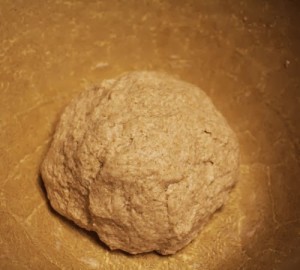 |
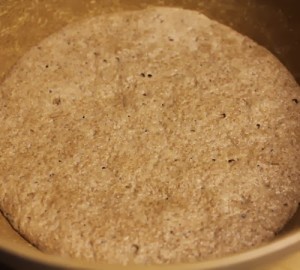 |
Mix the Final Dough:
Mix the ingredients using a Danish dough whisk or wooden spoon. The second time around, I found it helpful to add the sponge to the bowl first, and break it up with some of the water before adding the dry ingredients. Don’t add all of the water at this point because you may not need all of it. Add in flour and water gradually to make a workable dough. Knead the dough for a few minutes on a lightly floured counter. It will still be a bit tacky. Place it in a clean bowl and cover it with plastic wrap or a towel.
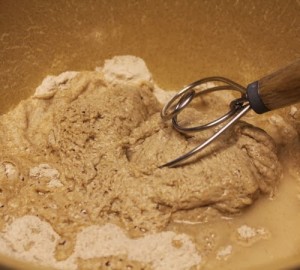 |
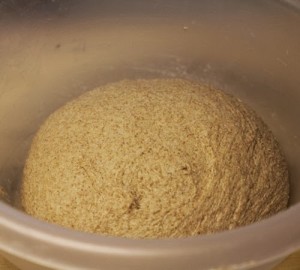 |
Bulk Fermentation:
Let the dough bulk ferment for 2 hours. After 1 hour, fold the dough and place it back in the bowl. Cover the bowl and let the dough proof for another hour.
Shape the Loaf:
When it is fully risen again, shape the dough into a boule and place seam side down in a floured banneton (proofing) basket for the final proof. I decided to test my new triangle proofing basket on this loaf. I dusted the basket with corn flour and placed the loaf in it to rise.
Alternately, shape the dough into a boule and let it rise on a floured board or parchment paper. As you can see from the photo below, I don’t like to waste parchment paper so I’m reusing it (again).
Cover the loaf so it doesn’t dry out.
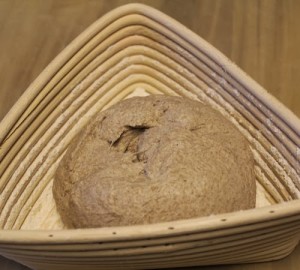 |
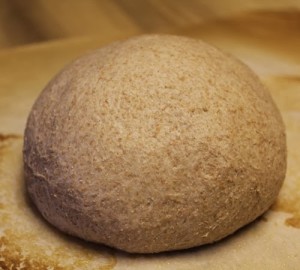 |
Proof the Loaf:
Let the dough proof until it is soft and full of gas. Poke the dough. If it leaves an impression and doesn’t spring back, the dough is ready. I let my loaves proof for about 45 minutes to an hour.
I wasn’t sure if the dough would fill up the triangle basket, but it did. I pressed it down lightly to fill in the corners.
Prepare the oven for baking:
Preheat the oven to 450 degrees F. with a baking stone on the bottom rack and a steam pan underneath or a cast iron skillet on the top rack.
Score the Loaf:
Gently turn the loaf out of the basket and onto parchment paper. Score the loaf in the pattern of your choice. I used a Longuet lame to score straight patterns on the triangle loaf and the Adour lame to score around the top of the loaf like I did on the Cuban Bread but this time I added some scoring around the sides of the loaf as well.
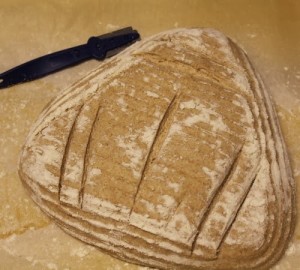 |
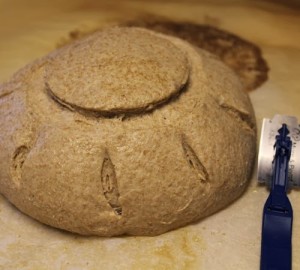 |
Baking the Loaf:
Slide the loaf (on the parchment paper) onto the preheated baking stone. Add hot water to the steam pan or several ice cubes to the iron skillet. Bake the loaf for 30 to 40 minutes. The crust will be brown and the bottom should sound hollow when thumped.
Cool the Loaf:
Cool the loaf on a wire rack to allow the air to circulate below the bread. Then slice and enjoy.
Here are the crumb shots for both loaves. The first loaf was a little more hydrated so it had some holes. I used less water for the second loaf so it had a tighter crumb. They both tasted delicious.
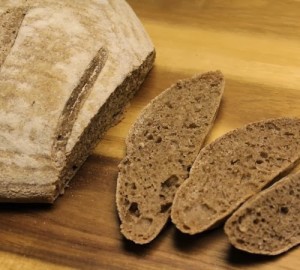 |
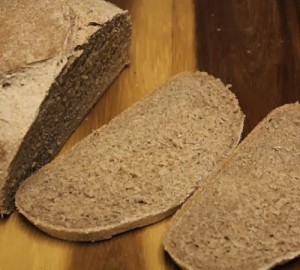 |
I want to thank Golden Wheat Farms for sending me the hard red winter wheat berries to test. The whole wheat flour I milled from the grains did really well in this bread.
Even though these loaves are made with the simplest of ingredients, they both tasted really good. The first loaf tasted good plain and dipped in oil and herbs. I enjoyed the second loaf with just butter or peanut butter.
I’m sharing these loaves with:
Happy Baking!
Cathy
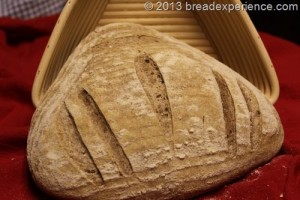
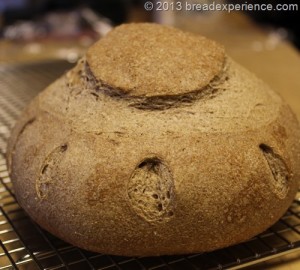
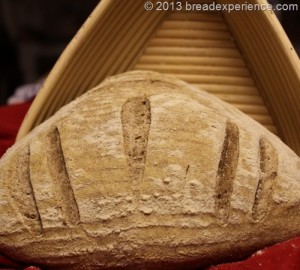
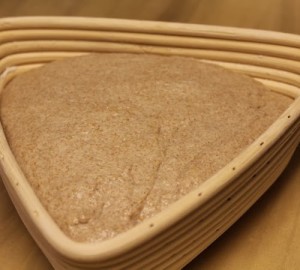
Karen Kerr says
That triangle looks so cool! Lucky you getting the wheat berries! Listen to me. Such a bread geek. =)
Cathy W. says
Thanks Karen! It was very nice of them to send me a sample.
One bread geek to another. Lol…
Sweet and That's it says
I love the triangualar shape, Cathy, but also the hat scoring. They are fabulous!
Which one did you prefer, the sifted or the unsifted whole wheat bread.
Thank you so much for sharing it with BYOB (ps: I haven’t received the link yet. Did the linkup work?)
Sweet and That's it says
I mean, if you had to remake them, would you sift the flour or not?
Cathy W. says
Thanks Carola, you’re too quick. I’ll link it up today.
I’m glad you asked. I liked both versions. If I was going to make it again, whether I would sift the flour (remove some of the bran), would depend on what I was using the bread for. The first loaf had a higher hydration so it was good for an artisan loaf. The 2nd loaf had a tighter crumb so it was good as a sandwich bread. I should probably add these comments to the post.
Soepkipje says
The link to Golden Wheat Farms is not correct says another bread geek. :-))
Cathy W. says
Soepkipje, thanks for catching that! The link has been fixed.